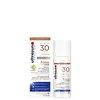What's inside
What's inside
 Key Ingredients
Key Ingredients

 Benefits
Benefits

 Concerns
Concerns

 Ingredients Side-by-side
Ingredients Side-by-side

Water
Skin ConditioningZinc Oxide
Cosmetic ColorantCoco-Caprylate/Caprate
EmollientPolyglyceryl-3 Polyricinoleate
EmulsifyingIsostearic Acid
CleansingCetearyl Alcohol
EmollientCetearyl Glucoside
EmulsifyingPentane
SolventTerminalia Ferdinandiana Fruit Extract
AntioxidantXanthan Gum
EmulsifyingGluconolactone
Skin ConditioningSodium Benzoate
MaskingGlycerin
HumectantAmmonium Acryloyldimethyltaurate/Vp Copolymer
Octyldodecanol
EmollientCaprylic/Capric Triglyceride
MaskingSodium Chloride
MaskingPEG-30 Dipolyhydroxystearate
EmulsifyingDisodium EDTA
Iron Oxides
Water, Zinc Oxide, Coco-Caprylate/Caprate, Polyglyceryl-3 Polyricinoleate, Isostearic Acid, Cetearyl Alcohol, Cetearyl Glucoside, Pentane, Terminalia Ferdinandiana Fruit Extract, Xanthan Gum, Gluconolactone, Sodium Benzoate, Glycerin, Ammonium Acryloyldimethyltaurate/Vp Copolymer, Octyldodecanol, Caprylic/Capric Triglyceride, Sodium Chloride, PEG-30 Dipolyhydroxystearate, Disodium EDTA, Iron Oxides
Water
Skin ConditioningCaprylic/Capric Triglyceride
MaskingPentylene Glycol
Skin ConditioningMethylene Bis-Benzotriazolyl Tetramethylbutylphenol
UV FilterTitanium Dioxide
Cosmetic ColorantEthylhexyl Salicylate
UV AbsorberGlycerin
HumectantBis-Ethylhexyloxyphenol Methoxyphenyl Triazine
Skin ConditioningC12-15 Alkyl Benzoate
AntimicrobialDiethylamino Hydroxybenzoyl Hexyl Benzoate
UV FilterAcrylates Copolymer
Ethylhexyl Triazone
UV AbsorberSilica
AbrasiveC8-22 Alkyl Acrylates/Methacrylic Acid Crosspolymer
Squalane
EmollientEctoin
Skin ConditioningCocoglycerides
EmollientHydrogenated Phosphatidylcholine
EmulsifyingVitis Vinifera Seed Extract
AntimicrobialDecyl Glucoside
CleansingPropyl Alcohol
SolventCetyl Alcohol
EmollientSodium Hydroxide
BufferingAlcohol
AntimicrobialCetyl Phosphate
EmulsifyingXanthan Gum
EmulsifyingPropylene Glycol
HumectantLecithin
EmollientTocopheryl Acetate
AntioxidantAscorbyl Tetraisopalmitate
AntioxidantTocopherol
AntioxidantDiisopropyl Adipate
EmollientUbiquinone
AntioxidantMica
Cosmetic ColorantCI 77492
Cosmetic ColorantCI 77491
Cosmetic ColorantCI 77891
Cosmetic ColorantCI 77499
Cosmetic ColorantWater, Caprylic/Capric Triglyceride, Pentylene Glycol, Methylene Bis-Benzotriazolyl Tetramethylbutylphenol, Titanium Dioxide, Ethylhexyl Salicylate, Glycerin, Bis-Ethylhexyloxyphenol Methoxyphenyl Triazine, C12-15 Alkyl Benzoate, Diethylamino Hydroxybenzoyl Hexyl Benzoate, Acrylates Copolymer, Ethylhexyl Triazone, Silica, C8-22 Alkyl Acrylates/Methacrylic Acid Crosspolymer, Squalane, Ectoin, Cocoglycerides, Hydrogenated Phosphatidylcholine, Vitis Vinifera Seed Extract, Decyl Glucoside, Propyl Alcohol, Cetyl Alcohol, Sodium Hydroxide, Alcohol, Cetyl Phosphate, Xanthan Gum, Propylene Glycol, Lecithin, Tocopheryl Acetate, Ascorbyl Tetraisopalmitate, Tocopherol, Diisopropyl Adipate, Ubiquinone, Mica, CI 77492, CI 77491, CI 77891, CI 77499
 Reviews
Reviews

Ingredients Explained
These ingredients are found in both products.
Ingredients higher up in an ingredient list are typically present in a larger amount.
This ingredient is an emollient, solvent, and texture enhancer. It is considered a skin-softener by helping the skin prevent moisture loss.
It helps thicken a product's formula and makes it easier to spread by dissolving clumping compounds.
Caprylic Triglyceride is made by combining glycerin with coconut oil, forming a clear liquid.
While there is an assumption Caprylic Triglyceride can clog pores due to it being derived from coconut oil, there is no research supporting this.
Learn more about Caprylic/Capric TriglycerideGlycerin is already naturally found in your skin. It helps moisturize and protect your skin.
A study from 2016 found glycerin to be more effective as a humectant than AHAs and hyaluronic acid.
As a humectant, it helps the skin stay hydrated by pulling moisture to your skin. The low molecular weight of glycerin allows it to pull moisture into the deeper layers of your skin.
Hydrated skin improves your skin barrier; Your skin barrier helps protect against irritants and bacteria.
Glycerin has also been found to have antimicrobial and antiviral properties. Due to these properties, glycerin is often used in wound and burn treatments.
In cosmetics, glycerin is usually derived from plants such as soybean or palm. However, it can also be sourced from animals, such as tallow or animal fat.
This ingredient is organic, colorless, odorless, and non-toxic.
Glycerin is the name for this ingredient in American English. British English uses Glycerol/Glycerine.
Learn more about GlycerinWater. It's the most common cosmetic ingredient of all. You'll usually see it at the top of ingredient lists, meaning that it makes up the largest part of the product.
So why is it so popular? Water most often acts as a solvent - this means that it helps dissolve other ingredients into the formulation.
You'll also recognize water as that liquid we all need to stay alive. If you see this, drink a glass of water. Stay hydrated!
Learn more about WaterXanthan gum is used as a stabilizer and thickener within cosmetic products. It helps give products a sticky, thick feeling - preventing them from being too runny.
On the technical side of things, xanthan gum is a polysaccharide - a combination consisting of multiple sugar molecules bonded together.
Xanthan gum is a pretty common and great ingredient. It is a natural, non-toxic, non-irritating ingredient that is also commonly used in food products.
Learn more about Xanthan Gum